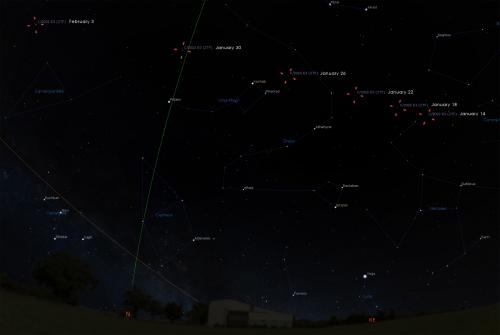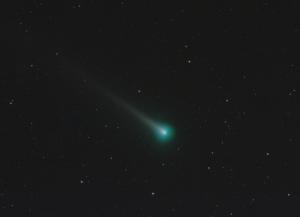Celebration of Space - January 27, 2023
Last week, on January 20, 2023 the Solar Dynamics Observatory (SDO) eclipse season began. Eclipse season happens twice per year for SDO, and will last about 3 weeks in length. During this time the SDO spacecraft, which observes the Sun in multiple wavelengths from a geosynchronous orbit around Earth, will have Earth get in the way, and eclipse parts or all of the Sun every day. The daily eclipse will last up to 72 minutes in length.
SDO is a satellite that continuously observes the Sun. The mission of SDO is to study solar activity and how that activity relates to space weather. The spacecraft’s numerous instrumentation will measure the Sun’s interior, atmospheres, magnetic field and more. Additionally, SDO publishes some of the best images of the Sun on a 15 minute basis. Check out the Sun at any given time, and you just may catch a view of an eclipse.
Now that Comet C/2022 E3 ZTF is making its final approach to Earth, at least for our civilization, the views are at their best. Since January 12, 2023, Comet E3 has been on its way towards Earth for a not-so-close encounter on February 1, 2023, at a distance of 26,402,319 miles distant. Now around February 1st will be the best time to view the comet due to its distance from Earth, but the Moon will reach its full phase on February 5th, which makes the sky not all that great for comet viewing on February 1st. Since the Moon is currently in the waxing crescent phase, and setting around midnight, the best time to see Comet E3 ZTF is now. But over the past week, some big things have happened with the comet.
Now that Comet E3 is approaching Earth, our viewing angle of the comet, and its tails, has become rather inopportune. Most of a comet’s tails will point away from the Sun, this is due to the Solar Wind being the reason the tails form, not the comet’s motion. As the comet passes Earth, it will do so on the opposite side of Earth than the Sun, which will place the tail on the other side of the comet and mostly out of our view. We have seen this start to happen over the past several days. But some comets will form another tail, called and anti-tail, which will point towards the Sun, and Comet E3 is forming one!
An anti-tail is a product of significant amount of dust and debris being blasted off the comet and left in the comet’s path around the Sun. Sunlight will illuminate this tail causing it to become visible. Sometimes a comet’s anti-tail can become visible for over 10º of the sky. Over the past week, Comet E3 has formed a rather impressive anti-tail, which will likely continue to grow.
This past week, Comet E3 also became circumpolar for our latitude. This means that the comet has moved into the northern sky, near the North Star (Polaris). The entire sky, in the Northern Hemisphere, will appear to spin around the North Star, with that star not visibly moving regardless of time or season. Any object that is within the altitude of the horizon to the North Star is considered circumpolar, and will not set below the horizon, but instead will just circle the North Star. Now that Comet E3 is circumpolar, it is in the sky for the entire duration of nighttime. Some reports we have read state that the comet has become naked-eye visible. Unfortunately, it’s been so cloudy here that we have been unable to confirm that, though we do not think it will be visible to the naked eye based on the measurements we have seen. Regardless, a binocular view will be spectacular! We created a finder chart for Comet E3 to assist with finding the comet. Take a moment this weekend to spot the comet.
Over the next several nights, evening passes of the International Space Station (ISS), and Tiangong – China’s space station, will continue over our region. With the rather cloudy weather of 2023 we have missed out on many of these passes over the past week or so, and Tiangong will be wrapping up evening passes on January 31, 2023, until it returns in early March. Here are a few notable passes for this weekend and coming week:
ISS:
Fri, Jan 27 at 5:59 pm, starting in the NNW, rising to 15º, heading towards the NNE, and into orbital sunset.
Sat, Jan 28 at 6:47 pm, starting in the NW, rising to 20º, and into orbital sunset.
Sun, Jan 29 at 5:58 pm, starting in the NNW, rising to 19º, heading towards the NE, and into orbital sunset.
Mon, Jan 30 at 6:46 pm, starting in the NW, rising to 38º, and into orbital sunset.
Tue, Jan 31 at 5:57, starting in the NW, rising to 31º, heading towards the ENE, and into orbital sunset.
Wed, Feb 1 at 6:45 pm, starting in the WNW, rising to 69º, and into orbital sunset.
Thu, Feb 2 at 5:56 pm, starting in the NW, rising to 69º, heading towards the ESE, and into orbital sunset. ← Awesome Pass!
Tiangong:
Fri, Jan 27 at 6:26 pm, starting in the W, rising to 49º, heading towards the SSE, and into orbital sunset.
Sat, Jan 28 at 5:26 pm, starting in the W, rising to 69º, heading towards the ESE.
Sun, Jan 29 at 6:03 pm, starting in the W, rising to 32º, heading towards the SE.
Tue, Jan 31 at 5:41 pm, starting in the WSW, rising to 20º, heading towards the SSE.
Make sure to set your alarms and step outside to catch a view of these fantastic passes of the stations whenever the clouds clear. For daily pass predictions of the stations and other bright satellites visit the Frosty Drew Daily Satellite Pass Prediction Utility.
- Author:
- Scott MacNeill
- Entry Date:
- Jan 27, 2023
- Published Under:
- Scott MacNeill's Columns




